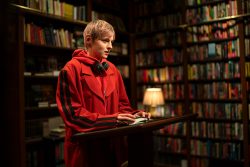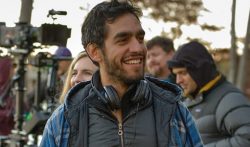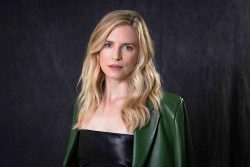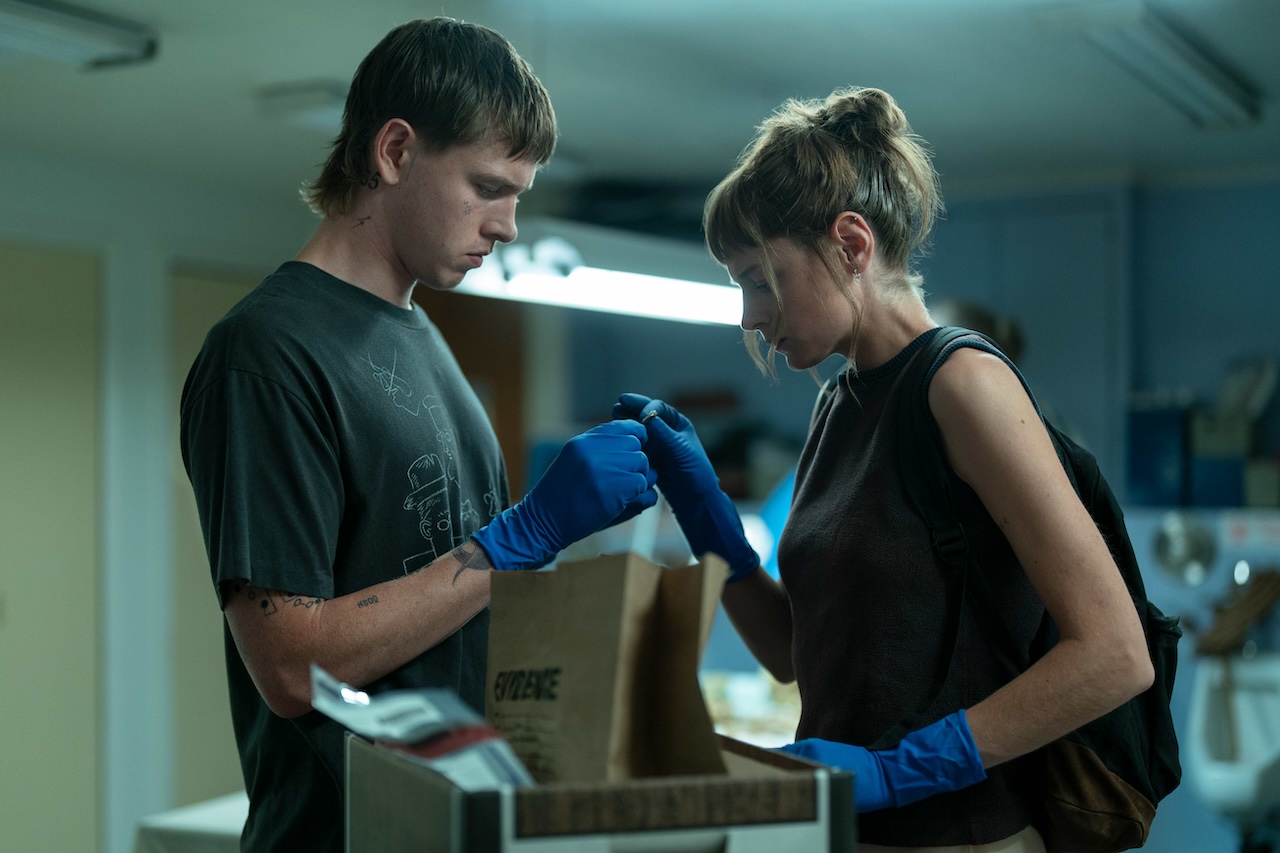This interview contains spoilers.
“Zal and I are both really big fans of mysteries. We feel that they’re often a cerebral puzzle. We wanted to write a mystery that felt hot-blooded, that had a fun intellectual puzzle to solve, that was wrestling with some of the big themes of our time, but also had a lot of depth of feeling, and was a challenge for the heart too,” elaborates Brit Marling (Another Earth, The OA) who co-created A Murder At The End Of The World with Zal Batmanglij (The OA, The East).
The lead character of the show Darby Hart (Emma Corrin) was born from this desire. Darby thrust herself in the middle of an investigation after a murder at an exclusive retreat battling climate change.
Darby is investigating both herself and the murder, making her character an exciting coming of age story. “You’re going to watch her change as much as the mystery is changing things around her,” continues Marling.
Darby Hart – Amateur Sleuth
A feature of Marling and Batmanglij’s collaboration is writing about amateur junior sleuths who give the more experienced detectives a run for their money. In the case of A Murder At The End of The World, the detective is Darby Hart, a junior female.
“I think that Darby’s age and gender were very important to us. But also, if you look at all the one hour dramas that have female leads, a vast majority of them are swapping out the male detective for a female detective. These were tried and true male archetypes. You just switch them out and substitute a woman and use all the ‘male’ elements… the badge, all the power and knowledge the badge confers,” adds Batmanglij.
“We imagine a young woman separate from a badge or from a traditionally male job, and the amateur sleuth was born so that she would be a detective in a fresh way that could match the kind of storytelling we wanted to do,” he continues. This is how the writing duo subverted the genre.

Darby Hear (Emma Corrin) Photo by Chris Saunders/ FX
“Part of how Bill Farrah (Harris Dickinson) was born as a character is the idea that he was going to invite Darby into spaces that she was uncomfortable in and challenge her to evolve,” states Brit. He’s not simply along for the ride.
The pair are drawn to each at the exclusive retreat based on their desire to connect with someone with shared interests, tastes, and obsessions. “You’re trying to self-define at that age. You’re trying to grasp your own personality and a sense of who you are,” expands Marling. This is how the writers tap into the YA elements of the show.
Both Bill and Darby are indeed obsessed with solving cold case crimes and encourage each other forward. Darby is a true crime novelist who met Bill online six years earlier, although the retreat is their first in person meeting. Their relationship begins when their investigation is promoted from Darby’s laptop to the real world. “Their burgeoning relationship means contending with the awkwardness and vulnerability in real time and real space. They no longer have the buffer of being between screens,” highlights Marling.
Darby is initially uneasy at their closeness and resists Bill’s invitations to greater intimacy or real connection. “I think that the series is asking what it means to live a life from the neck up – or just in the mind. It’s time for Darby to drop into the rest of her body and to be solving crimes through feeling and empathy as much as she is through logical rigor. Bill represents the catalyst for this.”
Batmanglij explains that Murder could have been a standard boy meets girl at a retreat YA love story, girl is murdered, and boy avenges her death. In this case, Darby isn’t the victim, but the detective instead after Bill is murdered. The show wasn’t just about “solving” Darby. It was about “solving” Bill too in terms of their coming of age.
The relative youth of our detectives demands they are comfortable in a hyper-connected world of technology where you can reach anyone at anyplace at any time. A Murder At The End Of The World also brings the importance of AI into the fold.
“Darby’s superpower is her ability to crowdsource and harness the powers and the anonymities and the access that the internet has to solve crimes,” says Brit. That said, most of Darby’s electronic tools such as her phone and laptop are taken away from her for most of the series which hamstrings her investigative efforts, but not thwart them. This forces her to learn a new set of analogue skills to solve the murder while also maturing as a person. “I’m not sure Digital Darby would have been able to solve this particular case,” quips Brit.
Technology is an enhancement rather than a necessity in our lives and the mystery can still be solved.
Writing The Show
Apart from swapping traditional gender crime show roles, the series plays out with the traditional structure of murder mysteries. The gathering and interrogation of the suspects is typically reserved for the first or second episode. In A Murder At The End Of The World, this happens in Episode 5.
“You had to do five hours of storytelling to prove to the audience that this young woman is a credible enough detective and she’s earned the right to question the guests. That’s not because we didn’t try to write it sooner. We tried to put that tentpole of the genre earlier in the place that normally goes. But no matter how we wrote the scene, the notes that we would get back are that it doesn’t feel real. Darby feels petulant,” says Zal.

Zal Batmanglij
So, Brit and Zal returned to Darby’s origin story of being the Coroner’s daughter who grew up on crime scenes, investigated them, and meeting other amateur sleuths online to hone her craft. “You had to build that whole world just to prove that she could stand over Bill’s body at the end of Chapter 2 and that the audience could think she might be able to solve his death. Normally, that moment would happen at the very beginning of a murder mystery. It’s a process of trying to retain enough that is familiar to the genre, but to put it in the places where the audience doesn’t buck against the fact that you’ve changed who the hero is,” explains Zal.
“I think one of the challenges was trying to get that first conversation between Bill and Darby after they’ve been apart for so many years, and they meet again at the end of Chapter 1 and trying to both backfill what had happened to them over that time, but not have it fundamentally be about that. What does that mean? Getting that feeling right in the screenwriting was really hard,” recalls Brit.
“I think everything was difficult because once you change one major thing in the genre like age and gender, you’ve changed a lot of things. And you have to do a math to do it. The most liberating part was when we got to the home stretch. By the time we got to interview the guests, we’d hit such a tried and true part of the genre, that from then on, it became really fluid and really a pleasure to write because of Brit’s instinct to write a hot-blooded mystery,” continues Zal.
Writing Collaboration
“I think part of how it all works is that we’ve known each other since we were in our early twenties and we started telling stories together in college. We’ve been doing it in one way or another ever since then. So there’s a real trust that’s earned over that amount of time. And also a shared language, shared interests in certain things. I think also we both really provoke each other into thinking about different things,” ponders Marling.
“There’s a space that exists between the two of us that has been really well tended to for a long time. It’s a landscape and we can meet there, walk in it, daydream, imagine… and tell stories from it. Usually they begin orally for a long time. And then as they solidify, we start to tell them to other people to see how they land. Then when we take that data back in and start to think about finally writing.”

Brit Marling
“A lot of stories have existed between us for years that still haven’t been written. They are waiting for the right conditions or circumstances in the world to emerge or in ourselves. Maybe we still have work to do on ourselves in order to be the kind of people who can facilitate them or achieve them?”
“So that’s the kind of work that we do. That thinking, debating, pondering, and questioning is so much more important than the actual physical writing part, which happens pretty effortlessly if you have your flight plan in order,” adds Batmanglij.
Writing Voice
We asked Brit Marling and Zal Batmanglij what defines their writing. “I think we’re very interested in outsiders versus insiders and the idea of what groups are established, or sanctioned, or have power. What does it mean to be an underdog outsider and to try to infiltrate it? What happens when you do?” asks Brit.
“I think there’s also been a desire to try to write the kind of women that we know in our lives – our mothers and our friends, that when I go to the cinema or turn on my TV, I often feel a little bereft for the lack of these deep, strong, complicated, evolved women that are in the world, but less in our storytelling,” continues Brit.
“When we’re reinventing genres we need to be more inclusive. I think the key to writing a murder mystery is probably to know your ending and to know that your ending has something to say. Once you have that ending, everything from there becomes quite clear in what you need to set up, who you need to set up, who the characters are, and where they have to move to arrive at that place,” concludes Marling.
